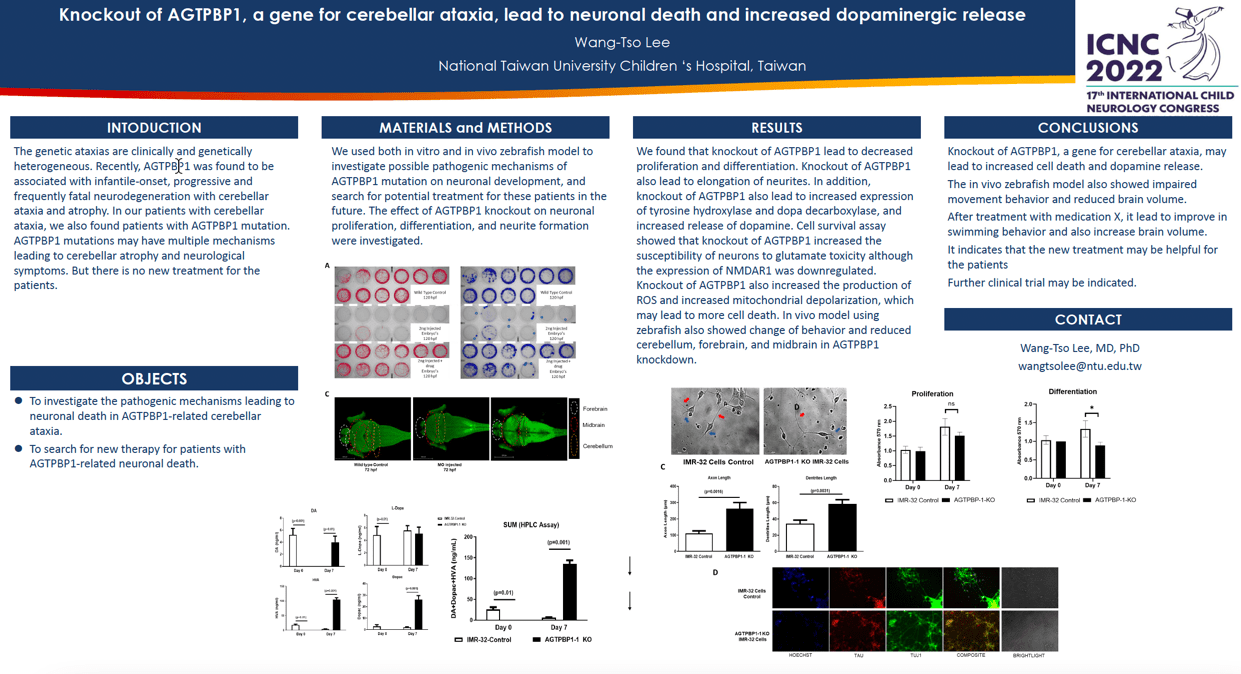Knockout of AGTPBP1, a gene for cerebellar ataxia, lead to neuronal death and increased dopaminergic release
Wang-Tso Lee
Objectives: The genetic ataxias are clinically and genetically heterogeneous. Recently, AGTPBP1 was found to be associated with infantile-onset, progressive and frequently fatal neurodegeneration with cerebellar ataxia and atrophy. In our patients with cerebellar ataxia, we also found patients with AGTPBP1 mutation. AGTPBP1 mutations may have multiple mechanisms leading to cerebellar atrophy and neurological symptoms. Methods: We used both in vitro and in vivo zebrafish model to investigate possible pathogenic mechanisms of AGTPBP1 mutation on neuronal development, and search for potential treatment for these patients in the future. The effect of AGTPBP1 knockout on neuronal proliferation, differentiation, and neurite formation were investigated. Results: We found that knockout of AGTPBP1 lead to decreased proliferation and differentiation. Knockout of AGTPBP1 also lead to elongation of neurites. In addition, knockout of AGTPBP1 also lead to increased expression of tyrosine hydroxylase and dopa decarboxylase, and increased release of dopamine. Cell survival assay showed that knockout of AGTPBP1 increased the susceptibility of neurons to glutamate toxicity although the expression of NMDAR1 was downregulated. Knockout of AGTPBP1 also increased the production of ROS and increased mitochondrial depolarization, which may lead to more cell death. In vivo model using zebrafish also showed change of behavior and reduced cerebellum, forebrain, and midbrain in AGTPBP1 knockdown. Conclusion: Knockout of AGTPBP1, a gene for cerebellar ataxia, may lead to increased cell death and dopamine release. Further investigation for possible treatment will be done based on the above findings.
Keywords: AGTPBP1 mutation,cerebellar ataxia
Wang-Tso Lee
National Taiwan University Children’s Hospital
Taiwan
Objectives: The genetic ataxias are clinically and genetically heterogeneous. Recently, AGTPBP1 was found to be associated with infantile-onset, progressive and frequently fatal neurodegeneration with cerebellar ataxia and atrophy. In our patients with cerebellar ataxia, we also found patients with AGTPBP1 mutation. AGTPBP1 mutations may have multiple mechanisms leading to cerebellar atrophy and neurological symptoms. Methods: We used both in vitro and in vivo zebrafish model to investigate possible pathogenic mechanisms of AGTPBP1 mutation on neuronal development, and search for potential treatment for these patients in the future. The effect of AGTPBP1 knockout on neuronal proliferation, differentiation, and neurite formation were investigated. Results: We found that knockout of AGTPBP1 lead to decreased proliferation and differentiation. Knockout of AGTPBP1 also lead to elongation of neurites. In addition, knockout of AGTPBP1 also lead to increased expression of tyrosine hydroxylase and dopa decarboxylase, and increased release of dopamine. Cell survival assay showed that knockout of AGTPBP1 increased the susceptibility of neurons to glutamate toxicity although the expression of NMDAR1 was downregulated. Knockout of AGTPBP1 also increased the production of ROS and increased mitochondrial depolarization, which may lead to more cell death. In vivo model using zebrafish also showed change of behavior and reduced cerebellum, forebrain, and midbrain in AGTPBP1 knockdown. Conclusion: Knockout of AGTPBP1, a gene for cerebellar ataxia, may lead to increased cell death and dopamine release. Further investigation for possible treatment will be done based on the above findings.
Keywords: AGTPBP1 mutation,cerebellar ataxia
Wang-Tso Lee
National Taiwan University Children’s Hospital
Taiwan

Wang-Tso Lee
National Taiwan University Children’s Hospital Taiwan
National Taiwan University Children’s Hospital Taiwan